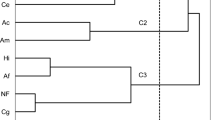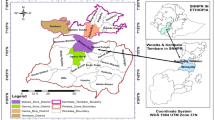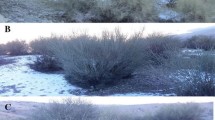Abstract
The study investigated diversity and frequency of occurrence of glomale (Arbuscular- or Vesicular Arbuscular-) mycorrhizal fungi on three farming systems in a drought prone and nitrogen deficiency site in southern Malawi. The farming systems comprised of two agroforestry systems of Sesbania sesban (L) Merr intercropped with maize and Sesbania macrantha E Phillips & Hutch. intercropped with maize and a maize monocrop systems without fertilizer, with nitrogen, phosphorus and a combination of nitrogen and phosphorus. Species diversity and species frequency of occurrence were examined in soil samples obtained in the dry and wet seasons. Twelve glomale mycorrhizal species were recorded, four species being in the genus Acaulospora, four in Glomus, two in Gigaspora and two in Scutellospora. Species diversity in the two agroforestry systems were not significantly (p ≤ 0.05) different but had lower species diversity than maize monocrop with only Sesbania macrantha intercropped with maize significantly (p ≤ 0.05) lower. Species diversity was significantly increased by the inorganic nitrogen fertilizer. Inorganic phosphorus fertilizer had no effect. The study shows that the occurrence and persistence of glomale species are influenced by agroforestry combinations, and that the spores of most species are tolerant to dry conditions. Only four species responded to fertilizer application with the occurrence of spores of some species high and some low. Management practices have great implication in the persistence of spore propagules of glomale species.
Similar content being viewed by others
References
M.O. Atayese O.O. Awotoye O. Osonubi K. Mulongoy (1993) ArticleTitleComparison of the influence of hedgerow woody legumes and cassava at the top and base of a hillslope in alley crop** system Biol. Fertil. Soils 16 198–204 Occurrence Handle10.1007/BF00361408
A.M. Ba Y. Dalpe T. Guissou (1996) ArticleTitleGlomales of Acacia holosericea, Acacia mangium Bios-et-Forets-des-Tropiques 250 5–18
Babara A. and Hetrick D. 1984. Ecology of VA Mycorrizal Fungi. In: Powell C.L.I. and Bagyaraj J.D. (eds), Mycorrhiza.CRC Press Inc., 36–54.
G.T.S. Baylis (1969) ArticleTitleHost treatment and spore production by Endogone N. Z. J. Bot. 7 173
Chambers C.A., Smith S.E. and Smith F.A. 1980. Effects of ammonium and nitrate ions on mycorrhizal infection, nodulation and growth of Trifolium subterraneum. N. Phytol. 85: 47.
Y. Dalpe C. Plenchette M. Gueye (2000) ArticleTitleGlomales species associated with surface and deep rhizosphere of Faidherbia albida in Senegal Mycorrhiza 10 125–129 Occurrence Handle10.1007/s005720000069
A. Gaur J.V. Greuning ParticleVan R.C. Sinclair A. Eicker (1999) ArticleTitleArbuscular mycorrhizas of Vangueria infausta Burch. Subsp. Infausta (Rubiaceae) from South Africa S. Afr. J. Bot. 65 434–436
P. Guadarrama A.F.J. Sanchez (1999) ArticleTitleAbundance of arbascular mycorrhizal spores in different environment in a tropical rain forestVeracruz, Mexico Mycorrhiza 8 267–270 Occurrence Handle10.1007/s005720050244
S.T. Ikerra J.A. Maghembe P.C. Smithson R.J. Buresh (2001) ArticleTitleDry season Sesbania fallows and their influence on nitrogen availability and maize yields in Malawi Agroforest. Syst. 52 13–21 Occurrence Handle10.1023/A:1010772520991
W.R. Jenkins (1964) ArticleTitleA rapid centrifugal-floatation technique for separating nematodes from soil Plant Dis. Rep. 48 692
M. Karachi (1995) ArticleTitleSesbania species as potential hosts to root knot nematode (Meloidogyne javanica) in Tanzania Agroforest. Syst. 32 119–125 Occurrence Handle10.1007/BF00711568
S. Khalil T.E. Loynachan H.S., Mcnabb SuffixJr. (1992) ArticleTitleColonisation of soybean by mycorrhizal fungi and spore populations in lower soils Agron. J. 84 832–836 Occurrence Handle10.2134/agronj1992.00021962008400050014x
F. Kwesiga R. Coe (1994) ArticleTitleThe effects of short rotation S. sesban planted fallows on maize yields Forest Ecol. Manage. 64 199–208 Occurrence Handle10.1016/0378-1127(94)90294-1
J.B. Morton (1988) ArticleTitleTaxonomy of VA mycorrhizal fungi: Classification, nomenclature and identification Mycotaxon 32 267–324
Onguene N.A. 2000. Diversity and dynamics of mycorrhizal associations in tropical rain forests with different disturbance regimes in south Cameroon. Ph.D. dissertation, Wageningen University and Research CenterWageningen, NL, pp 167.
M.E. Power L.S. Mills (1995) ArticleTitleThe keystone cops meet in Hilo Tree 10 182–184
D.J. Read D.H. Lewis A.H. Fitter I.J. Alexander (Eds) (1992) Mycorrhiza in Ecosystems CAB International UK
N.C. Schenck Y. Perez (1990) Manual for the Identification of VA Mycorrhizal Fungi (3rd ed.) Synergistic Publ. Gainesville, Florida
C.E. Shannon (1948) ArticleTitleA mathematical theory of communication Bell Syst. Tech. J. 27 379–423
K.D. Shepherd J. Jefwa J., Wilson J.K. Ndufa K. Ingleby K.W. Mbuthia (1996) ArticleTitleInfection potential of farm soils as mycorrhizal inocula for Leucaena leucocephala Biol. Fertil. Soils 22 16–21
Sieverding E. 1991. Vesicular-arbuscular mycorrhiza management in tropical agro systems. German Technical cooperation (GTZ) Eschborn. Federal Republic of Germany, pp. 52–59.
Sreenivasa M.N. and Bagyaraj D.J. 1990. Suitable source and level of nitrogen for mass production of VA mycorrhizal fungus Glomus fasciculatumIn Current Trends in Mycorrhizal Research. Proceedings of the National Conference on Mycorrhiza. HisarIndiap. 35.
J.P. Thompson (1987) ArticleTitleDecline of vesicular-arbuscular mycorrhizae in long fallow disorders of field crops and its expression in phosphorus deficiency of sunflower Aust. J. Agric. Res. 38 847–867 Occurrence Handle1:CAS:528:DyaL2sXmtFKltbk%3D Occurrence Handle10.1071/AR9870847
C. Walker C.W. Mize S.H. Mcnabb SuffixJr. (1982) ArticleTitlePopulations of endogonaceous fungi at tow locations in Central Iowa Can. J. Bot. 60 2518–2529
Author information
Authors and Affiliations
Corresponding author
Additional information
The order Glomale was revised in 2001 and upgraded to a phylum Glomeromycota.
Rights and permissions
About this article
Cite this article
Jefwa, J.M., Sinclair, R. & Maghembe, J.A. Diversity of Glomale Mycorrhizal Fungi in Maize/Sesbania Intercrops and Maize Monocrop Systems in Southern Malawi. Agroforest Syst 67, 107–114 (2006). https://doi.org/10.1007/s10457-004-2370-4
Received:
Accepted:
Issue Date:
DOI: https://doi.org/10.1007/s10457-004-2370-4




